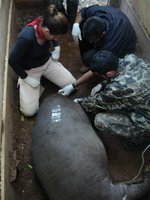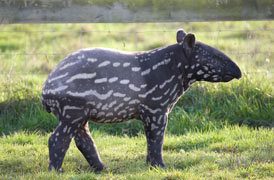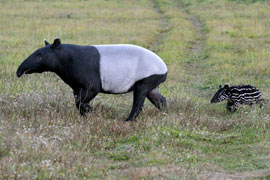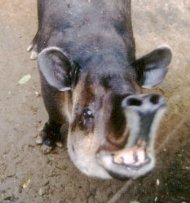 Colombo, a Baird's tapir at the
Colombo, a Baird's tapir at the
Kanazawa Zoo, Yokohama, Japan, 1997
There are so many more tapirs on the Web now than there were when The Tapir Gallery went online in 1996 - yes, it's been online that long! It's loads of fun looking at them! Of course, Google is a great way to find online tapirs using either the text search or the image search. We discovered recently that Google also has a news search, and it's an excellent way to find tapirs. Try both of these links: tapir and tapirs. Different listings come up when you use the singular and plural. From these links you can also subscribe to the Google Alerts for tapir news, and new posting links will arrive conveniently in your mailbox.
There is also an amazing number of references to tapirs in blogs these days. I like the Google blog search, myself.
Just a note of editorial here - OK, a rather long one, since I think it's important and have been dealing with it for about ten years. With so much posting and sharing (and I believe those are wonderful attributes of the Web), there is also a lot of stealing. That, I don't like. If you use an image, please ask the Web author or photographer for permission. It seems like a simple coutesy, but many, many people don't bother. The Tapir Gallery has given permission for students to use pictures in their school projects without asking first, but we do require them to give credit for where they got the images. If you want to make a birthday card for your mom or boyfriend, hey, don't worry about it. We're happy to have you do that. It's not a commercial or re-published use. You know what we're talking about - using images made by others and promoting them as your own work even if that's not stated.
The Tapir Gallery uses many of our own pictures, and we also use images supplied to us by others. We use them by permission and with credit. We believe it is OK to LINK to someone's image without asking, because by making a link a person is telling others where they got the image. We feel that this is important. Of course, if you do ask, you may get a link back, and that's a plus in the Web world.
We usually loan our pictures freely (depending on the project), and we appreciate credit and a link back to The Tapir Gallery (www.tapirback.com/tapirgal). If we don't know the photographer and we want to use an image on our site, we state that we don't know the source of the picture and will be glad to credit the owner when we find out who it is. We invite them to write to us. It's simply a matter of being honest. We appreciate it when other Web sites do the same.
I have been surprised over the years to see how many of my own tapir images (photos I took personally or that someone gave me to use) were posted on other Web sites with no credit. It's great to know that someone likes your pictures enough to want to use them, but it is also disconcerting because of the amount of time, energy, expense, artistic vision, and creativity that go into making pictures (photos or art) and posting them online. Everyone deserves credit for their work.
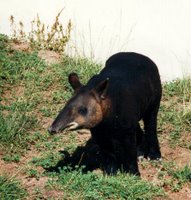 Left: A mountain tapir at the Colorado Springs Zoo. Photo by Sheryl Todd, The Tapir Gallery.
Left: A mountain tapir at the Colorado Springs Zoo. Photo by Sheryl Todd, The Tapir Gallery.
I recently found one of my original mountain tapir photos (shown at left) on a Web site that advertised photos that could be used "for free and without asking permission." I don't know how it got there, and when I wrote the Webmaster, the e-mail bounced. When I saw the same photo used without credit (of course, because they had gotten it from this "no-credit-needed" source), I contacted the authors, who were then happy to give the proper acknowledgement.
In addition to "giving credit where it is due," we, and most people publishing original work, try to give a context for the picture. I think this is very important. The species can be given correctly for identification, the location of the photo is given, and perhaps the circumstances of the photo are included. This interesting, informative, and often-educational material is usually lost when an image is stolen or mis-used, and that is unfortunate for anyone who loves these animals or simply needs the information in their research. Let's all try to play fair. It's not that hard. This post took approximately two hours. Yeah, original work does take time and thought.


